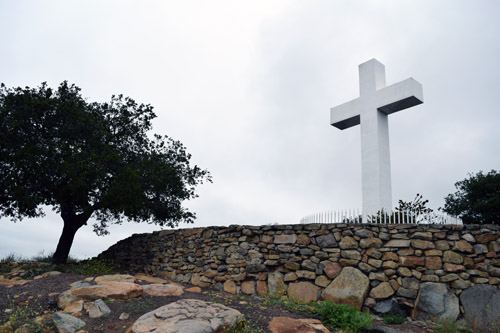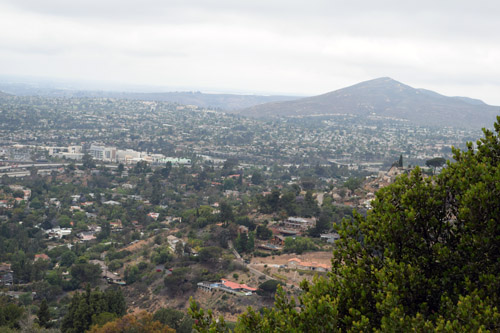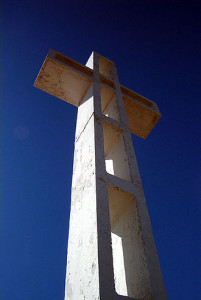
–45th in a Series–
Exit 14C: Fuerte Drive, La Mesa ~ Mt. Helix Amphitheatre
By Donald H. Harrison

LA MESA, California – The Christian cross atop Mount Soledad in the La Jolla neighborhood of San Diego is 29 feet tall, whereas the Christian cross atop Mount Helix here in La Mesa is 35 feet tall. The two crosses are quite different, and not just by 6 feet.
The Mount Soledad cross has been the object of contention and litigation since 1989, with the case going to the U.S. Supreme Court and back more than once, and still not resolved. On the other hand, the Mount Helix cross was the subject of litigation in 1990, but the issue was resolved satisfactorily in 1999. So what’s the difference, and what is the Jewish angle?
When suits were filed, both crosses were located on public lands, raising the constitutional question of whether the city of San Diego and the county of San Diego were showing a preference for Christianity over the many other religions that are practiced in the United States, including Judaism.
One of the plaintiffs in the Mount Soledad case, who has since died, was Philip K. Paulson, an atheist, who said the issue was even broader than that—the government should not show a preference for theism (the belief in God) over atheism. Paulson contended—as did the American Civil Liberties Union—that in order for Mount Soledad to become “kosher” – my word, not theirs– either of two actions could be taken. One: the cross could be removed from the public park on Mount Soledad and placed on private property. Or two, city-owned Mount Soledad park could be sold at auction, and if the purchaser wanted to keep the cross, that could be done, because the land would become private.
Initially, the same choices faced the County of San Diego concerning the cross atop Mount Helix, which towers over the amphitheater where Easter Sunrise services have been a tradition since 1917, when they were initiated by landowner Ed Fletcher. The land was sold in 1923 to Mary Carpenter Yawkey, who had the cross installed two years later. After she died, her brother Cyrus Carpenter Yawkey in 1929 deeded the land to the San Diego County government with the stipulation that the cross be maintained as a memorial to his sister.
After U.S. District Court Judge Gordon Thompson’ Jr.’s ruling was sustained that the crosses could not remain on public property, the county government concluded that it no longer was capable of fulfilling the terms of the donation. The cross, therefore, needed to be returned to the Yawkey family, or to some organization that represented its interests. It subsequently was ruled that the non-profit Foundation for the Preservation of the Mount Helix Nature Theatre—which later renamed itself as the Mount Helix Park Foundation — was qualified to be that organization, and could take possession of what was formerly a public park, provided that it received absolutely no public funds to do so.

Indeed, the area around the amphitheater at 4905 Mt. Helix Drive is beautiful to behold, with stunning views of San Diego and the Pacific Ocean to the west, and El Cajon and the Cuyamaca Mountains to the east. Besides being the site of occasional religious service, the amphitheater is utilized by the Christian Youth Theatre to put on various musicals including, you guessed it, Fiddler on the Roof.

(Photo: Wikipedia)
The Mount Soledad case was not resolved so easily. To tell every legal maneuver in the case would require more space, and time than most readers would be willing to devote.
Suffice it to say that advocates for keeping the cross where it stands eventually persuaded the City of San Diego to auction off the land under the cross, but the maneuver was adjudged in federal court to be unconstitutional because the use the land could be put to, in essence, was restricted to maintaining the cross. It was not like some real estate developer could do anything with such a small patch of land.
The city gave permission for a group to construct a veteran’s memorial around the Mount Soledad cross, with granite walls bearing images of fallen members of the U.S. military. This permitted advocates of retaining the cross on Mount Soledad to argue that Mount Soledad was principally a veterans’ memorial, not a place of religion, notwithstanding the cross, which was described as a universal rather than a religious symbol. This prompted opposition from the Jewish War Veterans of America who said, in essence, if Mount Soledad is to be a memorial to veterans, it should memorialize all veterans, not just the Christian ones.
The Mount Soledad Memorial Association persuaded local members of Congress to attach a rider to an appropriations bill permitting the federal government to obtain Mount Soledad from the City of San Diego. After the City Council balked at transferring the property, voters, in a referendum, agreed to the transfer by a margin of nearly 3-1. But a San Diego County Superior Court judge ruled that the transfer was an illegal act of preference for the Christian religion. That ruling, however, was overturned by a state appeals court.
Eventually, members of Congress—with the support of President George W. Bush—enacted legislation to have the federal government acquire Mount Soledad by eminent domain. This prompted another lawsuit, with the Jewish War Veterans and a private Muslim individual among the plaintiffs, contending the federal government had acted unconstitutionally to preserve a Christian symbol on public land. A federal district court judge ruled against the plaintiffs, but a federal appeals court reversed that decision, again ruling that the cross on public land was unconstitutional — no matter which level of government owned the land. An effort to appeal the decision to the U.S. Supreme Court was rebuffed, with the high court ruling that further action was necessary at the appeals court level before the case was eligible to be heard.
Congress than acted again, voting to sell a half acre of public land under the cross to the Mount Soledad Memorial Association for $1.4 million. As of 2015, a court ruling on the legality of this transfer still was pending.
Like Paulson, the original plaintiff in the case, Thompson, the original judge, has died during what has been a case that, up to this writing, has stretched on for 26 years. Perhaps both sides would agree with the adage that “justice delayed is justice denied.”
Meanwhile, the cross atop Mount Helix is warmed not only by the sun but by the fact of no longer being controversial.
*
From Exit 14C, turn right onto Fuerte Drive, then right again on Mt. Helix Drive, follow it bearing right on turns to the Mt. Helix Amphitheatre.
RE: The Cross on Mt. Soledad
The Cross is located in La Jolla,CA. Until 50 or 60 years ago, La Jolla was restricted community. One had to be Christian and (I think White) to live in La Jolla. In the 1980’s the San Diego newspaper used to have a full color picture on the first page, above the center fold, showing the Cross atop Mt. Soledad on the first page the day after Easter. It showed Easter services being celebrated there. Obviously, this created a lot of problems about having the Cross and religious services on public land. The powers that be figured that no one would go against having a war memorial there -even if it was just a ruse to keep the Cross there. When you add to the situation that it had been a huge white illuminated Cross on the highest point in the area, it certainly was sending a message.
–Stanley Back, La Jolla, California